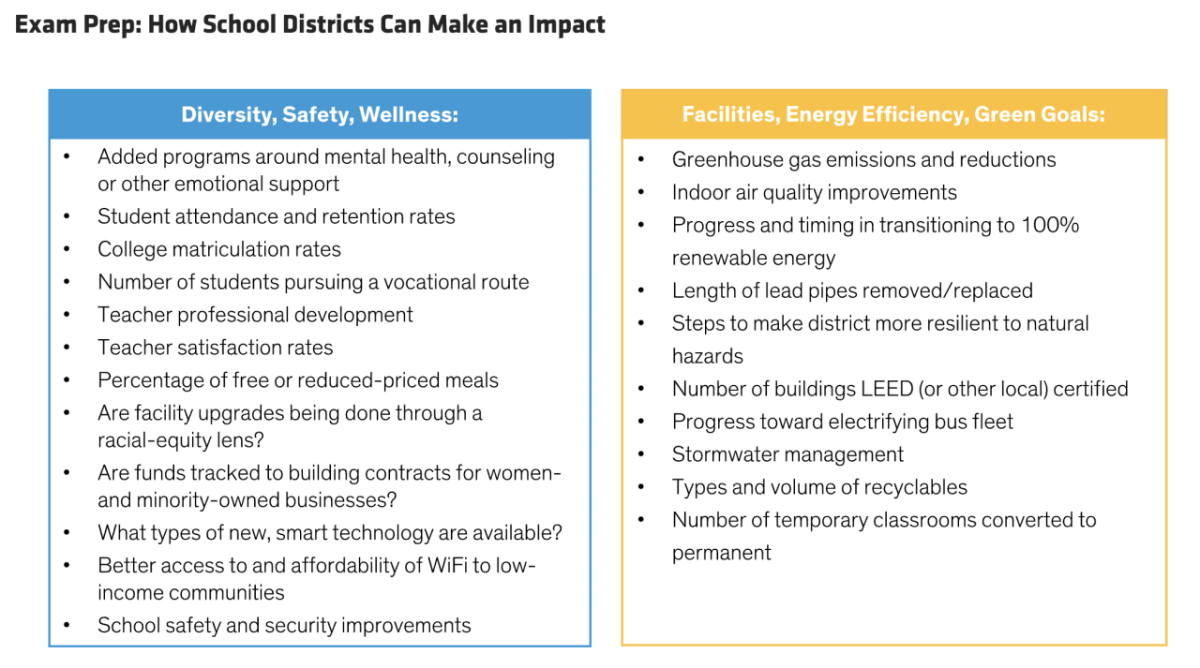AllianceBernstein: How Muni Impact Investors Can Help Issuers Ace Their ESG Tests
The degree of success of muni bonds that lift communities often stems from showing issuers how they’ll be graded.
Published 10-06-23
Submitted by AllianceBernstein

There’s no substitute for studying hard. But when the subject is expansive, it also helps to know what you’ll be graded on. Issuers of municipal bonds intended to help their communities are often at this crossroad: raising their hands to lend support but less certain on which approach to take, given the many possibilities.
Engagement Helps Set a Course for Impact
Proceeds from such muni bonds are typically used for specific purposes, helping move the needle on community-based social and environmental initiatives. The bonds should have clearly stated goals, like replacing lead water pipes, broadening mental healthcare access or funding school breakfast programs.
Determining the muni bond’s focus is only half the work, however, since investors also expect results. And not all such bonds work as advertised. The more transparent issuers fill out their report cards, using key performance indicators (KPIs) to help track progress and measure actual impact.
The need for support across communities continues to grow, expanding the potential scope of muni bonds that can help. More prospective issuers are on board, too, and are often open to suggestions on how to get started. This is where active investor engagement* adds a lot of value—examining options, determining purpose, setting expectations. With a clearer understanding of these, issuers can derive not just where to focus but likely how well they’ll meet investors’ ESG expectations.
Schools Are an Open Book of Impact Potential
Local school districts are a good example of engagement’s important contribution to the bond issuance and investment process. Most districts are struggling with helping students make meaningful progress, and with fewer teachers and shrinking revenues.
In practically every major city, district children seek mentors, classrooms lack supplies, and facilities need repairs, but resources are beyond stretched. For instance, the average age of school buildings is 70 years, with some surpassing 100.
This leaves the door open to a lot of impact bond projects that can make a difference, whether by providing new computers, stronger math and science curriculum, ensuring safer drinking water and stronger support networks for educators. In fact, data shows that improving school facilities and their general surroundings leads directly to significantly better long-term outcomes for students.
As school districts weigh their options, we help them consider key ESG projects or goals and define KPIs that would enable them to gauge progress for each (Display). Many districts share common problems, so some metrics are universal, but we also propose KPIs that target specific local challenges.

An environmental-impact focus, for instance, could fund projects to improve classroom energy consumption, air quality or stormwater management. Impact KPIs in this instance would track reduction in greenhouse gas emissions, subdivided by source, or document the types and volume of waste avoided or recycled.
School district muni bonds can have a social tilt too. For example, a construction project to retrofit a school cafeteria into a LEED-certified facility could commit and document support for local workforce diversity initiatives. Social impact metrics here would be whether the issuer set and met inclusion targets for women- and minority-owned enterprises among their contractors.
Students, of course, are the whole point, and metrics should paint a holistic picture of how well the issuer is educating them. Better grades and attendance are only part of the learning experience today and are more often just an extension of how connected, cared for, and safe our children feel in their schools.
Impact Metrics Vary by Focus Area
School districts by themselves offer a diverse ecology of community- or service-focused muni bonds and how investors measure results. Other focus areas, such as healthcare, energy and mass transit, also present impact metrics distinct to them, and we research and advise issuers accordingly.
For example, the number of Medicaid- and charity-funded cases and readmission rates are relevant hospital KPIs, while the percentage of low-income ridership and avoided carbon emissions are telling data for transportation- and energy-related muni bonds, respectively.
Municipal bond investors have a spectrum of responsible investing strategies at their disposal, from ESG integration to sustainable investing. For many, impact investing is a clear path to making a difference close to home. It also offers exciting opportunities for engagement, helping issuers sharpen their focus and improving overall outcomes for both communities and investors.
*AB engages companies where it believes the engagement is in the best interest of its clients.
The views expressed herein do not constitute research, investment advice or trade recommendations and do not necessarily represent the views of all AB portfolio-management teams. Views are subject to change over time.
Learn more about AB’s approach to responsibility here.

AllianceBernstein
AllianceBernstein
AllianceBernstein (AB) is a leading global investment management firm that offers diversified investment services to institutional investors, individuals, and private wealth clients in major world markets.
To be effective stewards of our clients’ assets, we strive to invest responsibly—assessing, engaging on and integrating material issues, including environmental, social and governance (ESG) considerations into most of our actively managed strategies (approximately 79% of AB’s actively managed assets under management as of December 31, 2024).
Our purpose—to pursue insight that unlocks opportunity—describes the ethos of our firm. Because we are an active investment manager, differentiated insights drive our ability to design innovative investment solutions and help our clients achieve their investment goals. We became a signatory to the Principles for Responsible Investment (PRI) in 2011. This began our journey to formalize our approach to identifying responsible ways to unlock opportunities for our clients through integrating material ESG factors throughout most of our actively managed equity and fixed-income client accounts, funds and strategies. Material ESG factors are important elements in forming insights and in presenting potential risks and opportunities that can affect the performance of the companies and issuers that we invest in and the portfolios that we build. AB also engages issuers when it believes the engagement is in the best financial interest of its clients.
Our values illustrate the behaviors and actions that create our strong culture and enable us to meet our clients' needs. Each value inspires us to be better:
- Invest in One Another: At AB, there’s no “one size fits all” and no mold to break. We celebrate idiosyncrasy and make sure everyone’s voice is heard. We seek and include talented people with diverse skills, abilities and backgrounds, who expand our thinking. A mosaic of perspectives makes us stronger, helping us to nurture enduring relationships and build actionable solutions.
- Strive for Distinctive Knowledge: Intellectual curiosity is in our DNA. We embrace challenging problems and ask tough questions. We don’t settle for easy answers when we seek to understand the world around us—and that’s what makes us better investors and partners to our colleagues and clients. We are independent thinkers who go where the research and data take us. And knowing more isn’t the end of the journey, it’s the start of a deeper conversation.
- Speak with Courage and Conviction: Collegial debate yields conviction, so we challenge one another to think differently. Working together enables us to see all sides of an issue. We stand firmly behind our ideas, and we recognize that the world is dynamic. To keep pace with an ever changing world and industry, we constantly reassess our views and share them with intellectual honesty. Above all, we strive to seek and speak truth to our colleagues, clients and others as a trusted voice of reason.
- Act with Integrity—Always: Although our firm is comprised of multiple businesses, disciplines and individuals, we’re united by our commitment to be strong stewards for our people and our clients. Our fiduciary duty and an ethical mind-set are fundamental to the decisions we make.
As of December 31, 2024, AB had $792B in assets under management, $555B of which were ESG-integrated. Additional information about AB may be found on our website, www.alliancebernstein.com.
Learn more about AB’s approach to responsibility here.
More from AllianceBernstein

